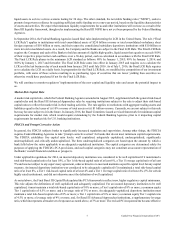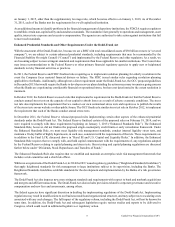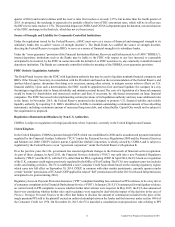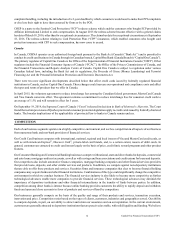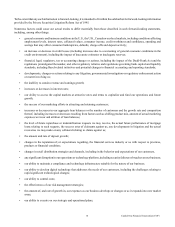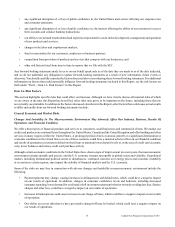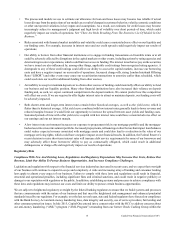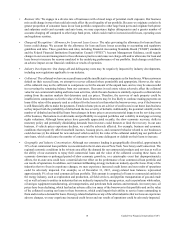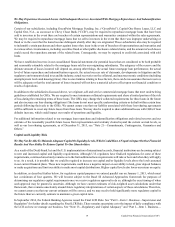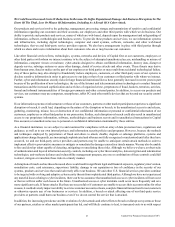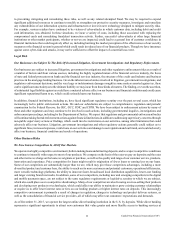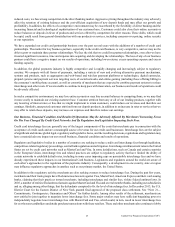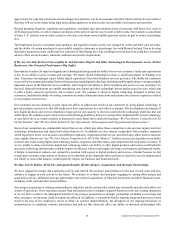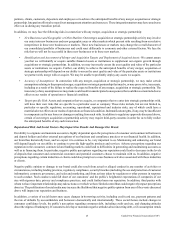Capital One 2015 Annual Report Download - page 35
Download and view the complete annual report
Please find page 35 of the 2015 Capital One annual report below. You can navigate through the pages in the report by either clicking on the pages listed below, or by using the keyword search tool below to find specific information within the annual report.16 Capital One Financial Corporation (COF)
• The process and models we use to estimate our allowance for loan and lease losses may become less reliable if actual
losses diverge from the projections of our models as a result of changes in customer behavior, volatile economic conditions
or other unexpected variations in key inputs and assumptions. As a result, our estimates for credit losses may become
increasingly subject to management’s judgment and high levels of volatility over short periods of time, which could
negatively impact our results of operations. See “There Are Risks Resulting From The Extensive Use Of Models In Our
Business.”
• Risks associated with financial market instability and volatility could cause a material adverse effect on our liquidity and
our funding costs. For example, increases in interest rates and our credit spreads could negatively impact our results of
operations.
• Our ability to borrow from other financial institutions or to engage in funding transactions on favorable terms or at all
could be adversely affected by disruptions in the capital markets or other events, including actions by rating agencies and
deteriorating investor expectations, which could limit our access to funding. The interest rates that we pay on the securities
we have issued are also influenced by, among other things, applicable credit ratings from recognized rating agencies. A
downgrade to any of these credit ratings could affect our ability to access the capital markets, increase our borrowing
costs and have a negative impact on our results of operations. Increased charge-offs, rising London Interbank Offering
Rate (“LIBOR”) and other events may cause our securitization transactions to amortize earlier than scheduled, which
could accelerate our need for additional funding from other sources.
• An inability to accept or maintain deposits or to obtain other sources of funding could materially affect our ability to fund
our business and our liquidity position. Many other financial institutions have also increased their reliance on deposit
funding and, as such, we expect continued competition in the deposit markets. We cannot predict how this competition
will affect our costs. If we are required to offer higher interest rates to attract or maintain deposits, our funding costs will
be adversely impacted.
• Both shorter-term and longer-term interest rates remain below historical averages, as well as the yield curve, which is
flatter than its historical average. A flat yield curve combined with low interest rates generally leads to lower revenue and
reduced margins because it would limit our opportunity to increase the spread between asset yields and funding costs.
Sustained periods of time with a flat yield curve coupled with low interest rates could have a material adverse effect on
our earnings and our net interest margin.
• A low interest rate environment increases our exposure to prepayment risk in our mortgage portfolio and the mortgage-
backed securities in our investment portfolio. Increased prepayments, refinancing or other factors that impact loan balances
could reduce expected revenue associated with mortgage assets and could also lead to a reduction in the value of our
mortgage servicing rights, which could have a negative impact on our financial results. In addition, the Federal Reserve’s
recent decision to raise short-term interest rates will increase debt service requirements for some of our borrowers and
may adversely affect those borrowers’ ability to pay as contractually obligated, which could result in additional
delinquencies or charge-offs and negatively impact our results of operations.
Regulatory Risk
Compliance With New And Existing Laws, Regulations And Regulatory Expectations May Increase Our Costs, Reduce Our
Revenue, Limit Our Ability To Pursue Business Opportunities, And Increase Compliance Challenges.
Legislation and regulation with respect to the financial services industry has increased in recent years, and we expect that oversight
of our business will continue to expand in scope and complexity. A wide and increasing array of banking and consumer lending
laws apply to almost every aspect of our business. Failure to comply with these laws and regulations could result in financial,
structural and operational penalties, including significant fines and criminal sanctions, and could result in negative publicity or
damage to our reputation with regulators or the public. In addition, establishing systems and processes to achieve compliance with
these laws and regulations may increase our costs and limit our ability to pursue certain business opportunities.
We are subject to heightened regulatory oversight by the federal banking regulators to ensure that we build systems and processes
that are commensurate with the nature of our business and that meet the heightened risk management and enhanced prudential
standards issued by our regulators. For example, over the last several years, state and federal regulators have focused on compliance
with the Bank Secrecy Act and anti-money laundering laws, data integrity and security, use of service providers, fair lending and
other consumer protection issues. In July 2015, Capital One entered into a consent order with the OCC to address concerns about
our anti-money laundering (“AML”) program (“AML Program”) emanating from our former Check Cashing Group within the



